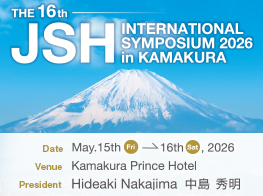.png)
EHA‒JSH Collaborative Exchange Program Award
Scientific Report
Awardee

Yoshitaka Sunami
Department of Hematology, Juntendo University School of Medicine
Research project
Mechanisms of oncogenic activation of JAK2/STAT signaling by frameshift mutants of CALR
Host institution and laboratory where the project will be conducted
Genetics of Hematological Disorders, Research Center for Molecular Medicine of the Austrian Academy of Science, Vienna, Austria
Host supervisor/mentor of the project
Robert Kralovics, MD
***************************
(1) JAK2, MPL, and CALR mutation in myeloproliferative neoplasms
BCR-ABL-negative myeloproliferative neoplasms (MPN), which is a group of hematologic diseases characterized by the clonal expansion of differentiated myeloid cells, are subclassified as polycythemia vera (PV), essential thrombocythemia (ET), and primary myelofibrosis (PMF). JAK2V617F, a somatic mutation on Janus kinase 2 (JAK2), is observed in 95% of PV cases, and 50 to 60% of ET and PMF cases (1-4). This mutation leads to constitutive JAK2 activation and is defined as a driver mutation in animal MPN models (5, 6). After the discovery of JAK2 mutation in MPN, JAK2 inhibitors were developed and have been used in clinical treatment (7). These agents reduce the systemic symptoms of MPN; however, JAK2 inhibitors rarely lead to cytogenetic or molecular remission. In addition, JAK2 inhibitors even block the function of wild type JAK2, which can cause anemia and thrombocytopenia as side effects. Therefore, a novel therapeutic strategy for MPN is essential.
In 2013, Dr. Robert Kralovics' laboratory (Research Center for Molecular Medicine of the Austrian Academy of Sciences; CeMM), my host laboratory, and another group discovered somatic mutations of the Calreticulin (CALR) gene in approximately 70% of ET and PMF patients not harboring JAK2 mutations (8, 9). Aside from JAK2 and CALR mutations, in 5 to 10% of ET and PMF patients, somatic mutations of the Myeloproliferative Leukemia (MPL) gene are detected, indicating that mutations in JAK2, MPL, and CALR account for most ET and PMF cases. MPL mutations are associated with increased Signal Transduction and Activator of Transcription (STAT), Extracellular Signal-regulated Kinase (ERK), and Protein Kinase B (AKT) signaling, as well as thrombopoietin (TPO)-independent growth. However, the detailed mechanism of how the mutant CALR causes MPN is not well understood.
(2) Understanding the mechanism of how mutant-CALR induces the development of MPN
Dr. Robert Kralovics' laboratory discovered somatic mutations of the CALR gene in ET and PMF patients not harboring JAK2 or MPL mutations using the Next Generation Sequencing system (8). They reported that the two main types of CALR mutations are insertions (Ins5) or deletions (Del52) in exon 9 of the gene, all of which result in a frameshift with the same reading frame and convert CALR C-terminal amino acid sequences from being negatively to positively charged. In addition, they demonstrated that the introduction of CALR mutant proteins to a murine pro-B cell leukemia cell line (Ba/F3) results in the autonomous activation of the JAK2/STAT signaling pathway and subsequent cytokine-independent cell growth. However, the exact mechanism by which the mutant CALR activates JAK2/STAT signaling in MPN patients and promotes the MPN development remains elusive.
Dr. Kralovics and his collaborators recently demonstrated that CALR mutants specifically activate MPL to induce constitutive activation of JAK2/STAT signalling and autonomous cell growth. Furthermore, they revealed that MPL is required for mutant CALR-induced thrombocytosis using MPN mice model (10). At the same time, they found that CALR mutants specifically activate MPL by the presence of its extracellular N-glycosylation residues and the glycan-binding site at the novel C-terminal tail of the mutant CALR (11). Furthermore, by knock-down assay in megakaryocytic progenitors from CALR mutation-positive MPN patients, they confirmed the crucial roles of MPL and JAK2 in CALR mutant-induced cytokine-independent growth of megakaryocytes. Dr. Komatsu's group, my home laboratory, also demonstrated that CALR mutants promote cytokine-independent cell growth in a human megakaryocytic leukemia cell line, UT-7/TPO, and the TPO receptor, c-MPL, is required for this cytokine-independent cell growth in these cells (12). All these studies suggested that mutant CALR promotes MPN development by activating MPL and its downstream pathway. Based on these findings, Dr. Kralovics' group is now attempting to develop a novel therapy for MPN patients.
(3) Laboratory work and meetings
I joined Dr. Kralovics' laboratory from September to December 2016. In the laboratory, I learned the ELISA assay to determine the concentration of CALR mutations and the fragment analysis to measure the mutant-CALR burden in MPN patients. For these assays, I collected CALR mutation-positive MPN patient samples. CeMM is located next to Vienna General Hospital (Allgemeines Krankenhaus; AKH) in the Medical University of Vienna, which is one of the biggest hospitals in Austria; therefore, it was easy to collect patient samples. Furthermore, as Dr. Kralovics collaborates with clinicians at Fondazione IRCCS Policlinico San Matteo and the University of Pavia in Italy, I could successfully collect a sufficient number of samples. Based on the achieved data, I discussed with my group members about the novel therapy for targeting mutant-CALR and its downstream JAK2/STAT signaling.
During my stay in CeMM, I joined the weekly lab meeting that all the group members attend. I discussed about the progression of the research with Robert and the other group members. The Lab Journal Club took place every other week. Postdoctoral researchers and PhD students attended and had a brief discussion of the manuscript about MPN, followed by an exchange of thoughts on the topic. I also joined the Friday seminar, which was held every Friday morning. All the CeMM members attend this meeting, and two researchers present about their projects. The topics presented were diverse, not only about hematological malignancies but also immune-deficiency, inflammatory disease and infectious diseases. To hear about topics from other fields was interesting and inspiring for me.
(4) Conclusion
My home institute in Japan, Department of Hematology, Juntendo University School of Medicine, is actively studying MPN pathogenesis and has been for several years. In addition, we have already analyzed almost 5000 samples from MPN patients (including suspected MPN patients) and have a large cohort database of Japanese MPN patients. Thus, I would like to measure the CALR mutation level/burden in Japanese MPN patients, and eventually compare the CALR mutation level/burden in European MPN cohorts with that in Japanese cohorts, which will lead to the establishment of novel diagnostic and predictive tools for MPN patients. Continuing this relationship will accelerate research that aims at the understanding of clinical characteristics and outcomes for MPN patients in Europe and Japan. Furthermore, the research may uncover the MPN pathogenesis, and finally lead to the development of a novel treatment for all MPN patients.
(5) Acknowledgement
I would like to thank Dr. Robert Kralovics and his group members for accepting me as a member of the group. I would also like to thank Dr. Bettina Gisslinger and Dr. Heintz Gisslinger at the Medical University of Vienna, Dr. Elisa Rumi, Dr. Mario Cazzola, and Dr. Daniela Pietra at Fondazione IRCCS Policlinico San Matteo and the University of Pavia for providing me the patient samples and clinical information. I appreciate Dr. Norio Komatsu and Dr. Marito Araki at Juntendo University School of Medicine for their support. Finally, I thank EHA and JSH for giving me the opportunity to have this precious experience.
(6) References
1. Kralovics R, Passamonti F, Buser AS, Teo SS, Tiedt R, Passweg JR, et al. A gain-of-function mutation of JAK2 in myeloproliferative disorders. N Engl J Med. 2005;352(17):1779-90.
2. Baxter EJ, Scott LM, Campbell PJ, East C, Fourouclas N, Swanton S, et al. Acquired mutation of the tyrosine kinase JAK2 in human myeloproliferative disorders. Lancet. 2005;365(9464):1054-61.
3. James C, Ugo V, Le Couedic JP, Staerk J, Delhommeau F, Lacout C, et al. A unique clonal JAK2 mutation leading to constitutive signalling causes polycythaemia vera. Nature. 2005;434(7037):1144-8.
4. Levine RL, Wadleigh M, Cools J, Ebert BL, Wernig G, Huntly BJ, et al. Activating mutation in the tyrosine kinase JAK2 in polycythemia vera, essential thrombocythemia, and myeloid metaplasia with myelofibrosis. Cancer Cell. 2005;7(4):387-97.
5. Akada H, Yan D, Zou H, Fiering S, Hutchison RE, Mohi MG. Conditional expression of heterozygous or homozygous Jak2V617F from its endogenous promoter induces a polycythemia vera-like disease. Blood. 2010;115(17):3589-97.
6. Marty C, Lacout C, Martin A, Hasan S, Jacquot S, Birling MC, et al. Myeloproliferative neoplasm induced by constitutive expression of JAK2V617F in knock-in mice. Blood. 2010;116(5):783-7.
7. Verstovsek S, Kantarjian H, Mesa RA, Pardanani AD, Cortes-Franco J, Thomas DA, et al. Safety and efficacy of INCB018424, a JAK1 and JAK2 inhibitor, in myelofibrosis. N Engl J Med. 2010;363(12):1117-27.
8. Klampfl T, Gisslinger H, Harutyunyan AS, Nivarthi H, Rumi E, Milosevic JD, et al. Somatic mutations of calreticulin in myeloproliferative neoplasms. N Engl J Med. 2013;369(25):2379-90.
9. Nangalia J, Massie CE, Baxter EJ, Nice FL, Gundem G, Wedge DC, et al. Somatic CALR mutations in myeloproliferative neoplasms with nonmutated JAK2. N Engl J Med. 2013;369(25):2391-405.
10. Marty C, Pecquet C, Nivarthi H, El-Khoury M, Chachoua I, Tulliez M, et al. Calreticulin mutants in mice induce an MPL-dependent thrombocytosis with frequent progression to myelofibrosis. Blood. 2016;127(10):1317-24.
11. Chachoua I, Pecquet C, El-Khoury M, Nivarthi H, Albu RI, Marty C, et al. Thrombopoietin receptor activation by myeloproliferative neoplasm associated calreticulin mutants. Blood. 2016;127(10):1325-35.
12. Araki M, Yang Y, Masubuchi N, Hironaka Y, Takei H, Morishita S, et al. Activation of the thrombopoietin receptor by mutant calreticulin in CALR-mutant myeloproliferative neoplasms. Blood. 2016;127(10):1307-16.
©THE JAPANESE SOCIETY OF HEMATOLOGY



